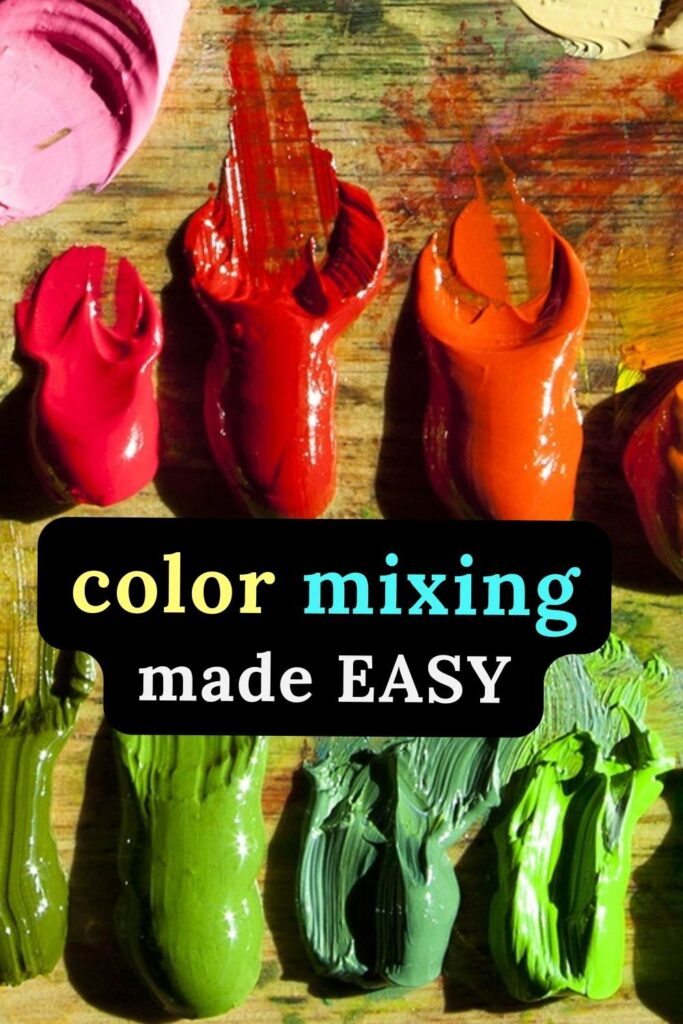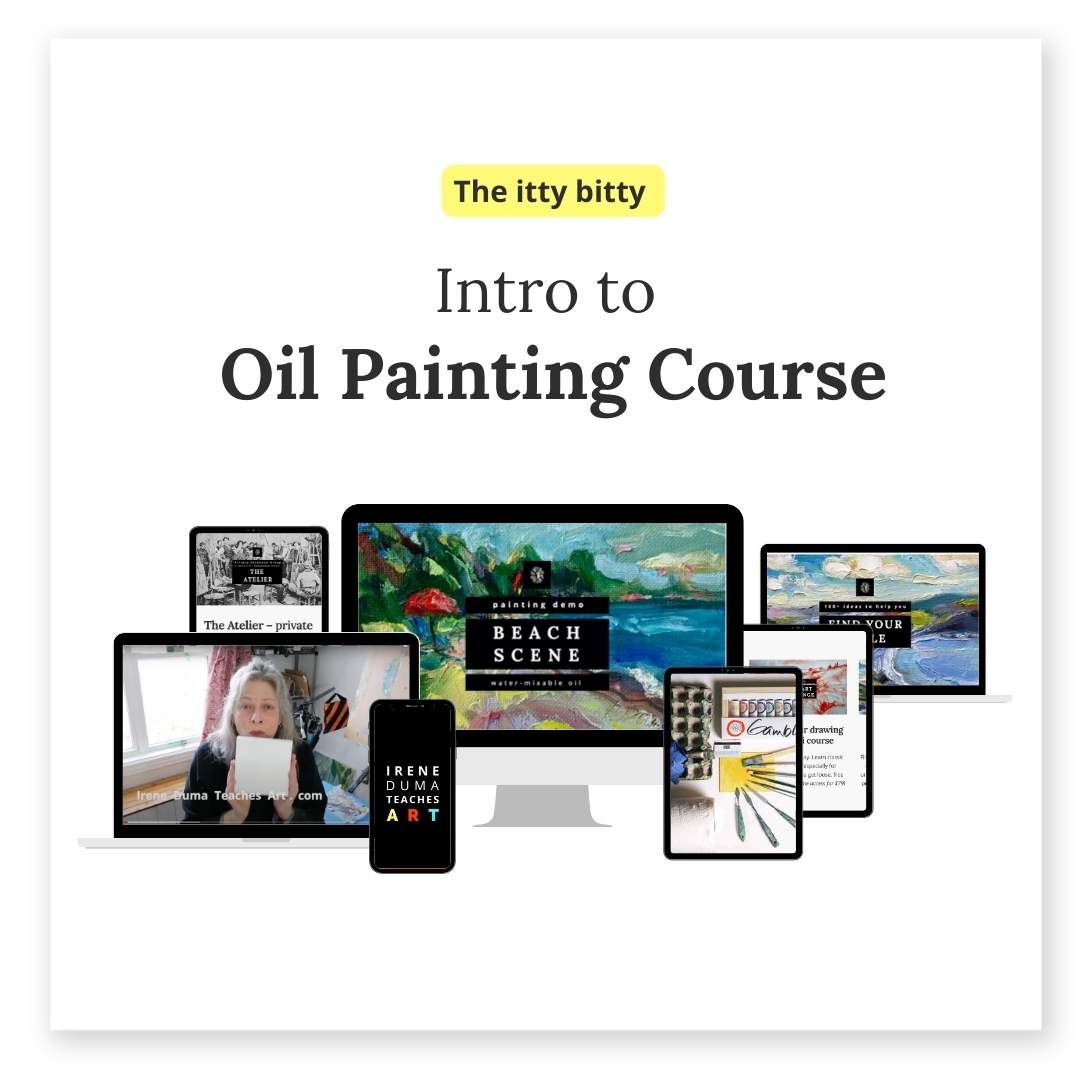Are you stumped by all the colors available at the art supply store? Not sure which colours for oil painting you should buy? Or which are best for beginners?
Then you will love the split primary colour palette.
This amazing oil painting palette works for beginners as well as masters. And you only need to buy 7 tubes!
It’s a very popular color palette because:
- you can mix almost all the colors with it
- it will help keep your paintings from becoming garish
- painting with a limited palette is the secret to beautifully harmonized paintings
- it works for all almost all paint mediums too: oil, acrylic, gouache and watercolour
- it’s lightweight and great for plein air painters or traveling
And here’s some BONUS content for you. Click here to download your QuickStart Guide to Oil Painting. It’s free. Easy to read. And designed to get you painting fast.
What is the split primary colour palette?
To make a split primary color palette, you need a warm and cool colour (pigment) for each of the 3 primary colours (yellow, red and blue). When we talk about warm and cool colours, we are referring to colour temperature.
The colours we need are:
- 3 cool colours: a cool yellow, a cool red and a cool blue
- 3 warm colours: a warm yellow, a warm red and a warm blue.

Then you add white to be able to mix the lighter tints.
So simple!
How do you choose the 6 colours when there are over 150 to choose from?
The 6 colours you choose are up to you. In fact, the colours you choose can lead to your own personal style!
Yes, there are plenty of paint colours to choose from. Paint is made from pigments mixed with a bonding agent. Pigments are what makes the colour. They can be made from all sorts of things: metals, minerals, synthetics, lamp soot, burnt bone and ground up mummies (Eek! True but thankfully this is not done anymore).
The pigments are the same whether you are using oil, acrylic or watercolour. When it comes to paint, the difference is what you mix the pigment with: for example, oil paint is pigment mixed with oil and acrylic paint is pigment mixed acrylic polymers.
Each pigment has its own property: some are more transparent than others. Some are opaque. Some dry faster, others dry slowly. Some have a strong colouring ability and you just need to add a dab to tint a colour (phthalo blue is known for this). Others have weaker pigmenting abilities, so you need to add a lot of paint (zinc white is less strong than titanium white).
You won’t know which ones you like best until you try. But luckily, trying and experimenting is half the fun of painting!
Here’s a useful page on Jackson’s Art that talks about paint pigments.
#DumaDoArtTip: if you paint a collection of paintings using all the same pigments, they will look great when hung together because the colours will be all harmonized! Very cool and so easy!
How do you know which colours are cool or warm?
There is no real technical way to know if a colour is warm or cool. Colour temperature is just a perception.
Cool colours can be thought of as icy blues, minty greens, lemony yellows. For landscape painters, the early morning is usually full of cool colours.
Warm colours are tropical blues, fiery reds, and sunny yellows. The late afternoon is usually bathed in warm colours.
If you are unsure, Gambin, a top oil paint brand, has put out a handy chart of pigments and their colour temperatures.
Please note: I disagree with them on ultramarine blue though — that’s ICY COLD! Brrr.
Supplementary colours to add to your palette:
Sometimes I add a few extra tubes to this palette. This is because paint pigments are made from ground up rocks, minerals, synthetics and NOT light waves. So we don’t get always get the colour we are looking for.
Some colours I might add are:
- a purple or magenta because these are hard to mix;
- a phthalo, turquoise, or viridian green to my mix because I live in Canada, and there are lots of green here in the summer. These colours will allow me to mix more wonderful shades of green.
- yellow ochre because when you mix it with white, it makes nice sunny highlights perfect for clouds and reflections.
- brown or transparent orange. Mixing browns with dark blues makes nice blacks so you don’t need to buy black paint which can be a little flat.
What oil paint brands are best?
As long as you are buying a reputable brand, you will be fine. They are all good.
You will want to try them all because each paint brand has its own formula. The colours may vary a bit because of the pigments they use. Also the paint texture might be different: some are thicker while others are runnier.
You won’t know what you prefer until you try, so try them all.
Here’s a short video:
#DumaDoArtTip: Just stay away from the cheap brands. You will never mix nice colours with them. They use low quality pigments and too much filler.
Many quality paint brands have two grades of paint: student quality oil paints are cheaper, and professional or artist-grade oil paints are more expensive.
Your colours will be more rich and beautiful when you use the artist-grade paints because they use better quality pigments and less filler.
#DumaDoArtTip: Choose the quality that you can afford. You do not want to be skimpy with your paint. But when you are ready to start upgrading your paint supplies, buy artist grade for the light or highlight colours first and watch your paintings really pop.
And that’s it. That’s all you need to mix all the colours! This was the best tip I ever learned and everything fell into place after this. I usually always paint with this colour palette and people compliment my colours all the time!


Ultramarine is classed as warm because it carries a quantity of red – the only blue that does. No blue is warm by comparison with other colours, but good quality ultramarine leans towards purple, which is generally described as “warm”.
Fuck Joe Biden
Fuck Joe Biden
I know a lot of folks whom I think would really enjoy your content that covers in depth. I just hope you wouldn’t mind if I share your blog to our community. Thanks, and feel free to surf my website Webemail24 for content about Website Design.
Yes, that’s the reasoning. But that’s an idea. Just look at the colour. Ultramarine blue is ICY cold. And phthalo blue is a tropical blue.